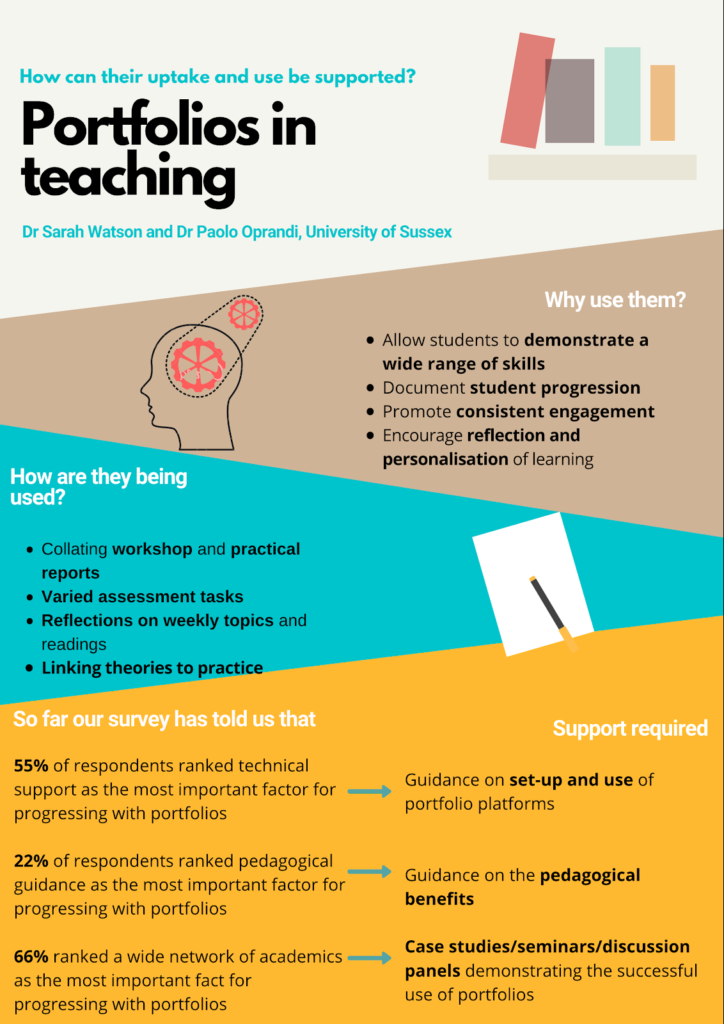By Dr. Sarah Watson & Dr. Paolo Oprandi
By the time that students have graduated from university, they will have completed a number of modules in order to obtain their degree. For each module they will usually have produced study notes, completed one or more pieces of work and received feedback on their assessments. These learning artefacts can be considered a portfolio of work showcasing a student’s academic and professional progression. It can be useful for students to return to this ‘portfolio’ after their studies to demonstrate various achievements throughout their university life.
The Careers and Employability Centre can advise students on producing these portfolios, but academic tutors can help with this too, particularly as the perception of portfolios continues to expand beyond an employability enhancement tool to embrace the idea of portfolios as an authentic, meaningful and student-centred form of teaching and learning.
Many tutors at Sussex are successfully using portfolios in their modules, either utilising our institutional digital platform Mahara or using other appropriate software. However, in light of increasing evidence for the pedagogical benefits of portfolio (Scully, O’Leary and Brown, 2018), we would still like to see a rise in the uptake of its use in teaching and assessment at Sussex. In order to achieve this aim, members of the Technology Enhanced Learning team will be developing support and guidance. To get a clearer idea of what tutors want in relation to portfolio support, we have created a questionnaire for all Sussex teaching staff to complete.
Here is a summary of our preliminary findings so far.

So far many tutors have shared their views on the value of portfolios. Many have found that portfolios have increased the inclusivity of assessments.
“Bringing diversity into the forms in which we assess students’ learning enhances inclusivity and provides empowering grounds for students to discover their learning skills and abilities.”
Marianela Barrios Aquino (International Relations)
“[Portfolios] can be a cumulative set of tasks that can be submitted over a term – meaning that students don’t have to submit just one big piece of work at the end that may be rushed.”
Liam Berriman (Social Work)
“[Portfolios] play to the diversity of students’ strengths”
Rachel Burr (Education)
“[portfolios can include]…creative reflection or video clips or something that you may not want to be the whole assessment can be used alongside other things to give students the maximum opportunity to demonstrate their skills.”
Emily Danvers (Education)
Many have related the importance of portfolios in ensuring students are engaged from the beginning to the end of the term through the portfolio linking activities directly to the assessment.
“Unlike essays, you will not be able to concentrate on just a few selected topics. Instead you should try to create links between the different elements of the module and to think carefully about the underlying meanings, connections and relationships between the texts with which you are dealing.”
Grace Carswell (Geography)
“[Portfolios] ensure consistent engagement with all aspects of a module through a teaching semester”
Simon Rycroft (Geography)
Others have noted how the tutor and the students themselves use the portfolio to track their progress. In one of Liam Berriman’s modules, the tutor and the students give feedback on parts of the portfolio over the term. Not only does this provide the opportunity for students to receive feedback, it also gives the tutor feedback on the academic progression of their students and offers insight into where students may need more support.
From responses to questions about what could help tutors develop their portfolio practice, three key requirements have started to surface:
- Technical support
- A wider network of staff using portfolio and sharing best practices
- Training (for both students and staff) on the pedagogical benefits of portfolios
Our brains are buzzing with ideas generated from the survey results so far as we start to plan our portfolio provision at Sussex. From our survey it is clear that technological and pedagogical principles go hand in hand, and that the digital platform tutors choose has to be fit for purpose and utilized in the right way to support teaching aims. With this in mind, it is our intention to run workshops that focus both on developing technical and pedagogical competencies surrounding the use of portfolios. Alongside these workshops, we would like to present a number of case studies where portfolios have been successfully implemented within teaching modules. These case studies may also form a panel discussion, whereby tutors using portfolios can discuss the strengths and potential pitfalls of this learning tool and thereby disseminate their knowledge and experience to fellow colleagues throughout the University of Sussex.
These ideas are still in the developmental phase as we haven’t finished collecting feedback and our survey is still ongoing. If you have not yet completed our survey, please complete our questionnaire to have your say.
References
Scully, D., O’Leary, M. & Brown, M. (2018). The Learning Portfolio in Higher Education: A Game of Snakes and Ladders. Dublin: Dublin City University, Centre for Assessment Research, Policy & Practice in Education (CARPE) and National Institute for Digital Learning (NIDL).


